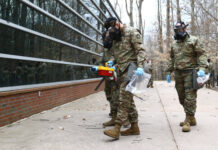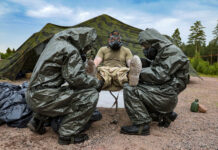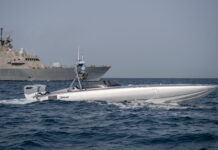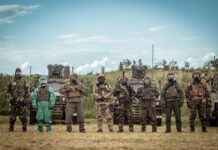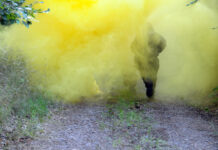Protecting military and emergency services personnel from chemical, biological, radiological, and nuclear hazards is inevitably a matter of equipment.
In military operations, size and weight are of particular importance. CBRN protection equipment is meant to be issued on a widespread basis across all parts of the military. For an infantry soldier or a special operations operator, every kilogramme of kit must be well-thought out. The issue of ‘combat load’ or ‘soldier burden’ weighs heavily in the minds of military planners. Historically, gas masks/respirators (the terminology varies) and protective suits will literally be competing for weight and space in a soldier’s kit with grenades, body armour, water, food, and ammunition. Items of kit that are large and/or heavy have faced an impetus to be made smaller and lighter. For things like CBRN protective equipment, which is designed against a threat often viewed as rare or exotic, there is every risk of things like suits and boots losing out to more ammunition or a spare radio battery.
‘Lightweight’ in terms of CBRN equipment can also take on other meanings besides weight. While ‘light’ can certainly be measured in terms of actual grammes and kilogrammes, we must also consider other ways in which something is light. In CBRN protective clothing and equipment, this often means lower heat burden. Weight, thickness, permeability, and other aspects of protective clothing can contribute to the heat burden of wearing CBRN protective equipment. Measures to reduce the heat burden can reduce the volume and weight of such equipment items. The opposite works as well, in that reducing factors such as weight and thickness, while maintaining protective capabilities, tends to reduce heat burden.
Militaries around the world have had an inexorable urge to make CBRN protective equipment lighter, smaller, and less burdensome. Since CBRN equipment competes with other equipment in a soldier’s combat load, making such equipment smaller and lighter means that it is better positioned to win such competitions and less likely to be jettisoned at the first opportunity. Sadly, the annals of military operations are replete with tales of CBRN kit being left in barracks.
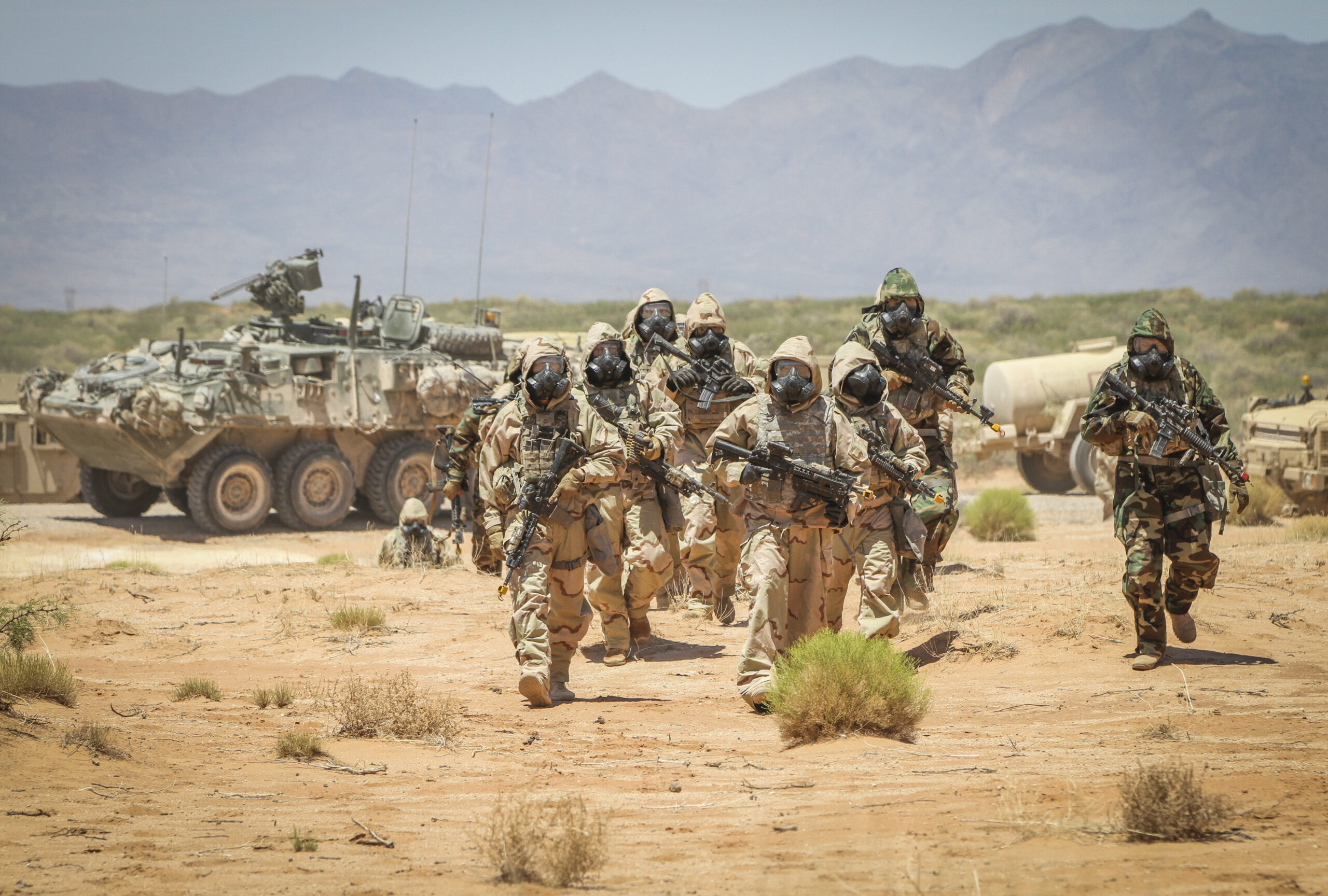
Credit: US Army/Sgt. 1st Class Brent C. Powell
As a matter of seriousness to commanders, wearing full or partial CBRN protective clothing has long had the reputation of reducing soldier performance at both combat and non-combat tasks, reducing morale, and increasing the likelihood of heat casualties. Chemical warfare is a category of threat that can be mostly alleviated by protective measures, but if these protective measures in themselves cause problems, the chemical warfare threat is still one that must be taken seriously.
Military leaders have long known, anecdotally and subjectively, that wearing protective clothing, makes it harder for soldiers to accomplish a wide variety of tasks. Many years ago, the US Army commissioned a serious study of this phenomenon and commissioned a number of studies in the late 1980s and early 1990s. While the detailed findings are available in summary in an Institute for Defense Analysis document through the excellent US DoD’s ‘Defense Technical Information Center’ (DTIC), I can summarise the findings quite readily. Wearing full or partial chemical protective clothing and masks caused serious performance degradation across the board in every conceivable type of military task, both individual and unit tasks.
Protective clothing
Perhaps the area where CBRN equipment has made the most significant strides is protective clothing. In the beginning years of the Cold War, impermeable suits made of material like butyl rubber or rubberised cloth were commonplace as military PPE. Heat stress made such clothing unbearable in many climates, and many countries, including most of the NATO alliance, migrated towards permeable types of protective clothing, which had lighter heat stress.
The US Army’s own progression in chemical protective suit over this correspondent’s career is a useful example. The M3 toxicological agent protective (TAP) ensemble could take the better part of an hour to put on, and would easily kill the wearer in hot clothing unless literally hosed down with water. It was never intended for widespread use and was supplanted by permeable suits with charcoal material to absorb and adsorb chemical threats. The Chemical Protective Overgarment (CPOG) of the 1970s and 1980s gave way to the somewhat lighter and better Battle Dress Overgarment (BDO) starting from the end of the 1980s.
Eventually, in the 1990s, non-charcoal textiles with protective capability started supplanting charcoal suits. They have a degree of breathability, lower heat stress, and greater comfort. Newer fabric technologies are launderable, whereas the older charcoal suits were not. The massive Joint Service Lightweight Integrated Suit Technology (JSLIST) programme at the US DoD procured hundreds of thousands of suits and is still in use. JSLIST is over twenty years old now, and due for replacement. Further developments in protective textiles has resulted in a newer US military programme called the Uniform Integrated Protective Ensemble (UIPE) programme.
This US-based example has mirrored the general approach taken by CBRN protection manufacturers around the world. Nobody enters into a CBRN procurement discussion from a standpoint of ‘we want thicker and heavier, and this means that basically every CBRN protective clothing manufacturer is trying to make products that maintain protection while being lighter and provide less heat burden on the user. A number of companies around the world are active in this space. OPEC CBRNe (based in the UK) is a leader in the space, with lightweight CBRN suits named for birds – the Falcon, the Kestrel, and the Kite. For some applications, their chemical protective undergarment is a useful tool.
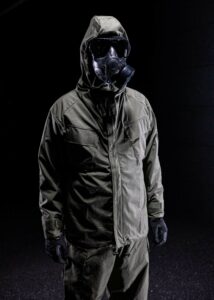
Credit: Photo by OPEC CBRNe used with permission
Blücher (Germany) is still a leader in the field, riding on the success of its Saratoga product line that became the US JSLIST suit. Paul Boyé (France) and W. L. Gore (USA) are both active in the area as well, and have participated in some of the US UIPE work. Gore’s Chempak selectively permeable fabric draws on their decades of work in the field, which has made “Goretex” a household name. Blauer (USA) fields a line of suits using Gore Chempak. A deeper dive into protective clothing was in this publication in October 2021, and the broad dynamics of that market remain unchanged.
CBRN suits get far more attention than the humble glove, yet gloves are an important part of protective clothing. The US Army studies mentioned above demonstrated that rather a lot of the performance degradation in essential tasks, including combat tasks and vital maintenance tasks, is due to gloves. For decades, thick butyl rubber gloves were the military standard. Such gloves often made many tasks difficult and some tasks, in vital areas of maintenance and medical care, were very difficult indeed. Newer fabric gloves go a long way towards remediating this issue. While these newer gloves are not always lighter in weight, they are definitely lighter in burden upon the operator, and should be considered in this space. CQC (UK) and W.L. Gore are examples of two companies with non-rubber CBRN gloves.
Even more humble than the glove is the boot. This has been an area of less improvement than other components of a protective clothing ensemble. Many CBRN boots and overboots remain the same as ever. However, one aspect of development that trends towards the lightweight is that the same technologies that benefit suits and gloves can make a sock. Perhaps the way forward here is to not actually field unwieldy CBRN boots but to field a sock that can go underneath a normal combat boot.
It should also be noted that there are a multiplicity of protective clothing manufacturers and products in the civil emergency services market. Their specifications are more driven by regulatory requirements than military standards and are usually designed against different use cases.
Masks
CBRN respiratory protection is also part of the lightweight revolution. Protective masks (often called respirators in some countries) are often the most critical component to military CBRN protection and are a valuable part of force protection in contaminated environments. The weight of a mask is important in several ways. First, if it is heavy or large, a mask, which is often carried on the hip of a soldier, may become unpleasant to carry.
Second, heavy masks become a burden when worn and cause discomfort. Such lessons are not always learned by militaries. This correspondent, in his early career in the US Army Chemical Corps, managed a battalion’s transition from the old M17A2 protective mask to the then-new M40 mask. A common complaint at the time was that the new mask was significantly bulkier when worn on the hip, compared to the older mask.
The US military clearly moved in a different direction after the M40. The new Joint Service General Purpose Mask (JSGPM), the M50-series, is made by Avon Protection (UK). It is clearly lighter and more compact than its predecessor. But the JSGPM makes another improvement in operator burden, one which points out one of the long-standing issues in filter-based CBRN masks. The US Army claims that breathing resistance is much lower with the M50 series, compared to its predecessors. Breathing resistance is the phenomenon wherein the user has to inhale harder than he or she would in ambient air without a mask, in order to draw air through the filter elements. Breathing resistance increases heat stress, fatigue, discomfort, and other unpleasant aspects of wearing a mask. Masks with lower breathing resistance feel less burdensome, if they are not appreciably smaller or lighter in weight terms. Exhalation resistance is also a factor, it should be noted, as carbon dioxide build-up and heat stress can be issues if there is significant resistance exhaling. Avon’s excellent product shows that great improvements can be made in inhalation and exhalation resistance while still maintaining a degree of filtration that meets acceptable military standards.

Credit: Photo by Avon Protection, used with permission
Lightweight Escape Masks
It is very much worth noting that not every CBRN protection application requires the full burden and operational endurance of a military mask. Many manufacturers have developed lighter systems for quick use by people with less amounts of training. Such items are often referred to with phrases like “quick masks”, “escape masks”, or similar. These masks and hoods fill a useful operational niche, especially in protection of civilians. Full-spec military masks usually come in sizes, need a bit of training, and need to be properly fitted and maintained in order to afford the full scope of their protection. They are also designed for use in rugged environments for days at a time.
There is ample scope in many scenarios for quick, easy to use, good-enough-to-save-a-life lightweight protection. Such equipment may not meet, or even need to meet, the more stringent requirements placed upon standard military equipment or emergency services equipment, which is usually governed by strict occupational safety standards. There has long been an accepted need for this category of equipment. Some earlier efforts were fraught with difficulty. One product was forced into a recall. However, a number of excellent products are now on the market in this segment that could rightly be considered lightweight.
Once again, we can look at Avon Protection for an example. Their CH15 Compact Escape Hood is a filtered hood which will give at least thirty minutes protection against Sarin and Sulfur Mustard threats, while having quite low inhalation resistance. Impressively, the CH15 weighs only 508 g. For applications where emergency escape, rather than staying to fight the battle, are the imperative, such a product probably does the job.
Other approaches have been tried by other manufacturers. One product of long-standing is the Victim Rescue Unit (VRU), by Essex Products (USA), with longstanding customer bases in the US Air Force and Department of Homeland Security. The VRU makes no attempt to filter air. Instead, it inflates from an oxygen cylinder, while protecting the head with a heat-resistant hood. ILC Dover (USA), perhaps more famously known for NASA space suits and the M40 mask, has a filtered powered device known as the SCape.
Other areas of CBRN equipment: Detection
Most discussions of lightweight CBRN equipment focus, quite rightly, on respiratory protection and clothing. However, no full account of this subject area can ignore developments in other equipment categories that are decreasing in the area of weight and volume. The areas that come immediately to mind are detection and decontamination.
Detection has made enormous strides in reducing size and weight. When this correspondent started his career three decades ago, the state of the art in the US Army were two detection devices, the M8A1 chemical agent alarm and the Chemical Agent Monitor (CAM). The M8A1 was about the size of two shoe boxes and weighed nearly 7 kg. It used a specialty battery that weighed a kilogramme. The CAM, made by UK company Graseby (now Smiths Detection) was nearly 2 kg. These days, the state of the art in portable chemical warfare detection is the M4 JCAD, also known as the LCD, made by Smiths Detection. An LCD 3.3 is 580 g, with batteries, and those batteries are four commercial AA batteries. The LCD 3.3 is also far more capable that the earlier detectors.
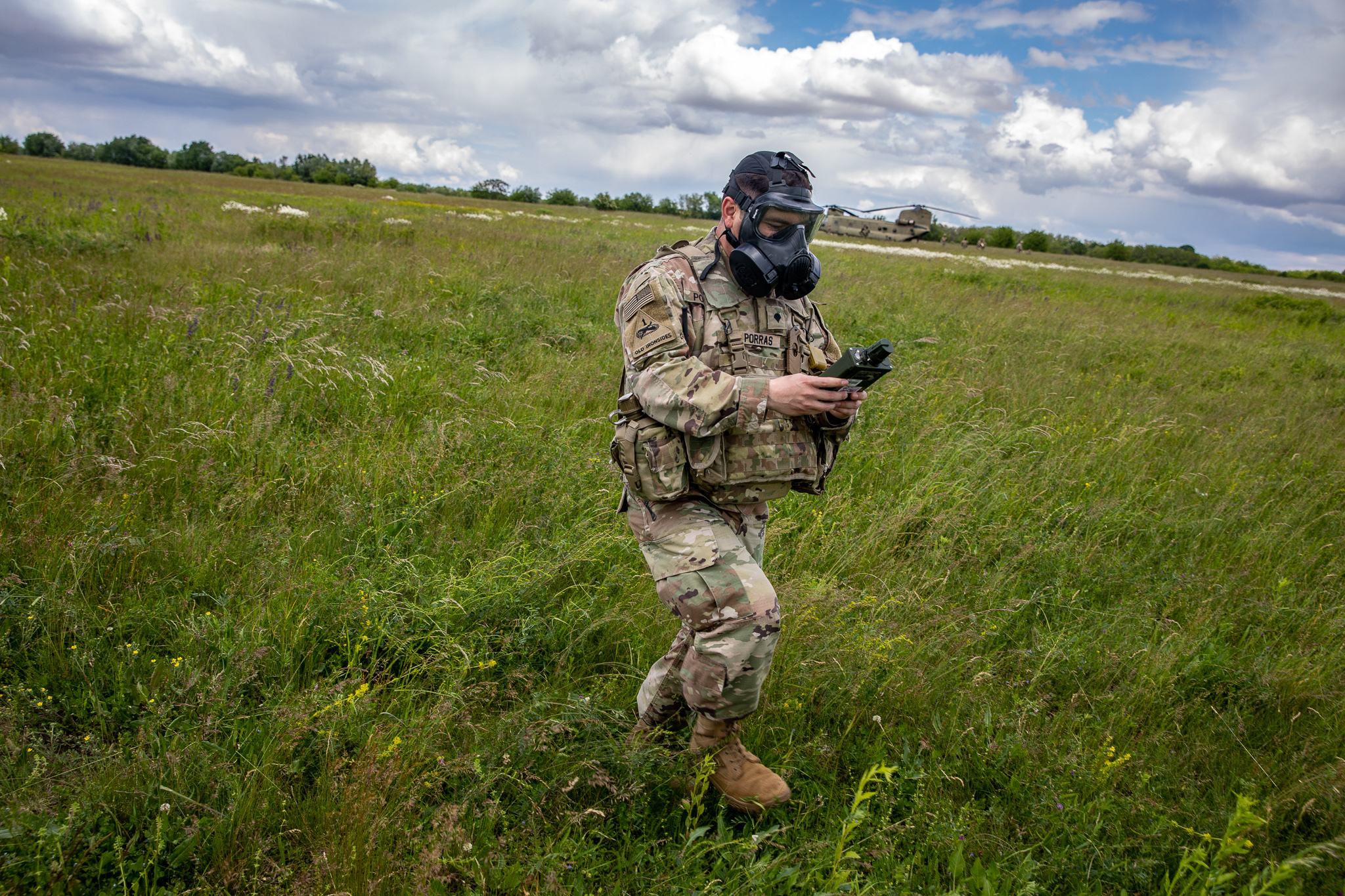
Credit: US Army/Sgt. Preston Malizia
A specific technical development, the use of corona discharge, which alleviated the need for a radioactive source and the shielding material around it, is part of the reason that the JCAD/LCD can be smaller. The other reason that the JCAD/LCD is small is that electronics of every type are getting smaller. We have and use small electronic devices in our daily life that were unthinkable in previous decades. This has affected detection equipment across the CBRN realm. Devices that were once only available as benchtop (or even larger) items are now man-portable or handheld. Examples include gas chromatograph and mass spectrometers, used for chemical identification, and isotope identifiers, used in radiation response.
Decontamination
The last area for consideration in “lightweight” CBRN protection is decontamination. Lightweight is a particularly relative concept in decontamination. At the risk of simplification, military CBRN decontamination can be broadly divided into plumbing and chemistry. There have been improvements in both aspects. Decontamination sprayers and ancillary equipment have become smaller, lighter, and consume less power than many of their predecessors. An example is the American M26 Joint Service Transportable Decontaminating System Small Scale, made by DRS (USA), which is about one fifth of the weight of the old Cold War era M12 Decontamination System that your correspondent trained on in the early 1990s. The key European decontamination players such as Kärcher (Germany), OWR (Germany), and Cristanini (Italy) have all recently produced systems that are lighter and lower power burden than their older catalogue items. There are practical physical limits, but such trends are likely to continue.
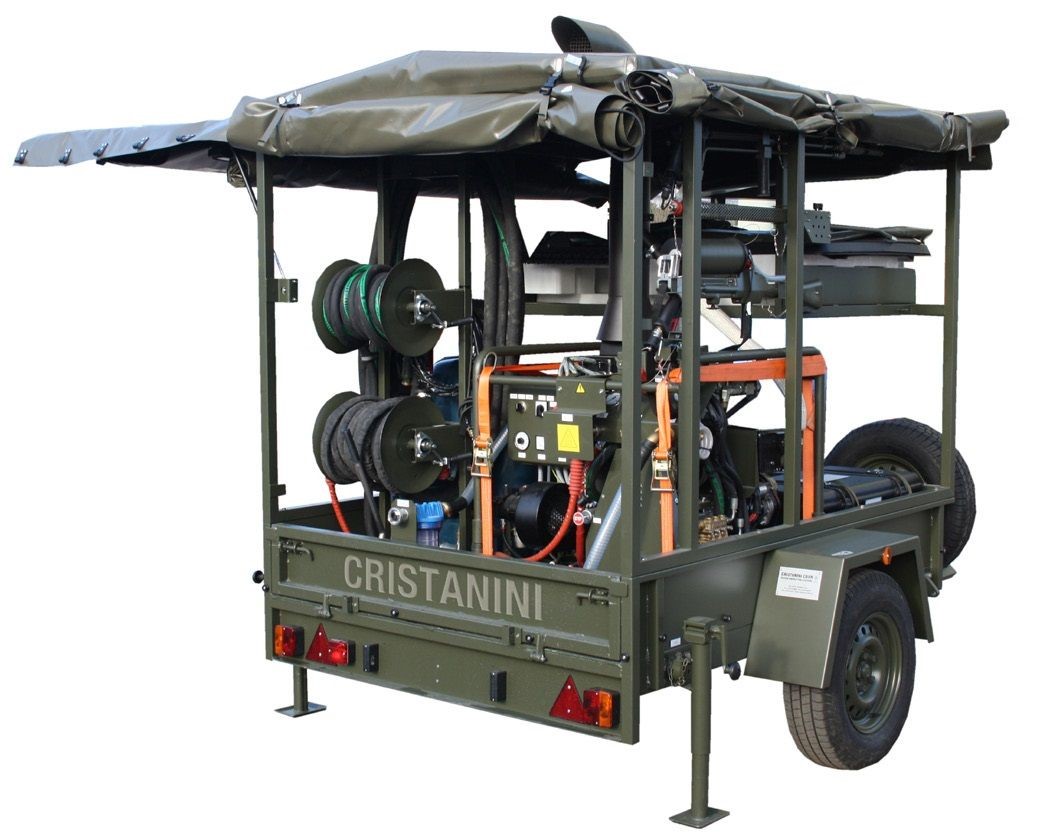
Credit: Cristanini s.p.a.
Chemistry has made modest inroads in that some of the newer decontamination solutions are more efficient, per gramme or litre, than earlier options. Of course, proprietary decontamination chemicals are in direct competition with low cost or free generics. The ‘lighter’ option, such as a specialty decon foam, may be far more costly. The economics of decontamination will vary greatly from scenario to scenario and from user to user. In a desert environment, water might be at a premium. On battlefields near coastlines and rivers, water for decontamination may be, in effect, free.
Truly lightweight decontamination for military purposes remains in the future, but some technological breakthroughs show promise. For decades now, scientists have been exploring the subject of enzymatic decontamination. Such an approach would use small amounts of enzymes to work as catalysts to, in layperson’s terms, greatly increase the rate of effect of other processes, like water reacting with chemical warfare agents. Where this becomes “lightweight” is that the amount of enzyme needed for nerve agents or blister agents is, in logistical terms, quite small. Exactly how small remains to be seen, but some scientists envisage situations on the order of magnitude of a teaspoon of enzyme in a large tank of water. Different types of chemical threats will likely require different quantities of enzymes.
Conclusion
The overall trend across the industry is towards lighter and less burdensome products. To put it more bluntly, there is not much of a constituency for heavier and more burdensome equipment. Most end users, if given a choice, will opt for lightweight choices if other factors such as protective capability are roughly equal. The most important advances have, clearly, been in individual protection. But advances in other equipment areas are not insignificant.
Where does all of this lead? Current trends will continue, and necessary equipment will continue to get lighter. Will we get a chemical detector the size of a watch? Eventually.
Nobody has quite reached the ‘Holy Grail’ in lightweight CBRN protection yet. Such a development might take the form of a chemical warfare protective suit that is functionally identical to the normal combat uniform of a soldier. Developments in textiles show that we are not that many years from such a possibility if a major military customer would commit to underwriting such a course of action.
Dan Kaszeta




![Nanotechnology: Threats and prospects in the CBRN sector US Airmen from the 426th Air Base Squadron conducting chemical, biological, radiological and nuclear (CBRN) training at KNM Harald Haarfagre, Stavanger, Norway, on 20 May 2025. [USAF/A1C Adam Enbal]](https://euro-sd.com/wp-content/uploads/2025/09/CBRN-Norway_USAFA1C-Adam-Enbal-Kopie-218x150.jpg)
![Danish acquisition programmes Danish soldiers training in Kangerlussuaq, Greenland, during June 2025. [Forsvaret/Rebekka Gimm]](https://euro-sd.com/wp-content/uploads/2025/07/Danish-Soldiers-in-Greenland-Kopie-218x150.jpg)
